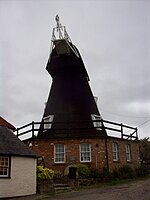Poison Cross railway station
Disused railway stations in KentFormer East Kent Light Railway stationsPages with no open date in Infobox stationRailway stations in Great Britain closed in 1928Railway stations in Great Britain opened in 1925 ... and 1 more
Use British English from August 2015
Poison Cross railway station was a railway station on the East Kent Light Railway. It opened in May 1925 and closed to passenger traffic on 1 November 1928. There was a passing loop and a siding.
Excerpt from the Wikipedia article Poison Cross railway station (License: CC BY-SA 3.0, Authors).Poison Cross railway station
Foxborough Hill,
Geographical coordinates (GPS) Address External links Nearby Places Show on map
Geographical coordinates (GPS)
| Latitude | Longitude |
|---|---|
| N 51.2537 ° | E 1.3076 ° |
Address
Poison Cross
Foxborough Hill
CT13 0NY , Eastry
England, United Kingdom
Open on Google Maps





